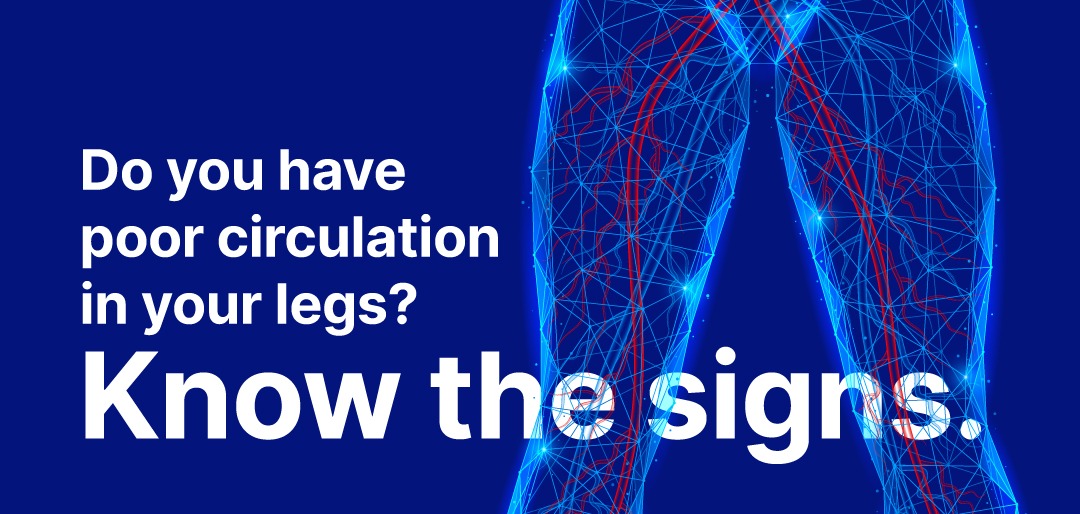If you have leg pain when walking, cold feet at night, or a sore that won’t heal, it could be more than aging — it may be a circulation problem called vascular disease.
When blood doesn’t flow well to your legs and feet, tissue can begin to break down. Without treatment, this can lead to serious infection or even amputation.
Rahul Kar, MD, a vascular surgeon at Adena Health, sees it far too often.
“If someone has a wound and poor circulation, they should get it checked right away,” he says. “The longer they wait, the worse it gets. That’s when we see patients who end up needing an amputation.”
The good news is that there are clear warning signs, simple screenings, and effective treatments that can help prevent serious complications. Here’s what to know.
Know the signs and symptoms of poor circulation
There’s no need to live with cold feet and pain or risk symptoms turning into larger issues. After all, when you know what to look out for, you can ensure that you catch poor circulation early on.
One way to stay proactive about your vascular health is being aware of risk factors or warning signs for vascular diseases. These include conditions that can damage the arteries and reduce blood flow — especially to the legs and feet — as well as other factors that affect your circulation.
You may be at higher risk for vascular disease if you have:
Diabetes
A history of smoking
High blood pressure
High cholesterol or hyperlipidemia
Heart disease or Coronary Artery Disease
Whether or not you have the above risk factors, you should still be on the lookout for symptoms of circulation problems. This way you can alert your doctor right away.
Common symptoms of circulation problems include:
Pain or cramping in the legs when walking (called claudication)
Pain in the feet at night
Cold, numb, or tingly feet
Wounds or sores that won’t heal
Skin that looks pale, shiny, or discolored
“At night, blood flow slows down, and the legs are farthest from the heart,” explains Dr. Kar. “That’s when some people start waking up with pain.”
Vascular screenings can help catch problems early
The most common reason people lose a limb to vascular disease is that they didn’t know they had it. Early symptoms can be subtle, like slow-healing sores, changes in skin color, or discomfort that’s easy to dismiss as “just getting older.” Without care, those small issues can progress to something much more serious.
“People develop ulcers that become gangrene,” says Dr. Kar. “Once there’s too much tissue loss, the foot may not be salvageable.”
That’s why vascular screenings are so important — especially if you have a chronic condition or symptoms that could point to poor leg circulation. At Adena Health, we offer quick, non-invasive tests to check your blood flow:
Ankle-Brachial Index (ABI) — compares blood pressure in your ankle and arm
Arterial Ultrasound — a non-invasive vascular screening that uses sound waves to detect narrowed or blocked arteries
These simple tests can guide treatment and give you peace of mind.
Advanced treatment options at Adena
If a circulation problem is found, Dr. Kar and his team offer a full range of care options — including advanced, minimally invasive procedures right here in our region:
Angiogram — same-day imaging to identify blockages
Balloon angioplasty and stenting — opens narrowed blood vessels
Atherectomy — clears out plaque and calcium buildup
Surgical bypass — reroutes blood flow using a graft or vein when needed
“Everyone develops some blockage over time,” Dr. Kar says. “The key is knowing when it’s severe — and that’s when we can help.”
But treatment doesn’t end after one visit.
“This is a lifelong condition,” he adds. “Even after a procedure, we need to monitor for recurrence and help patients manage their health moving forward.”
Lifestyle makes a difference
One of the biggest things you can do to protect your circulation? Don’t smoke.
“People often think smoking just causes lung issues,” says Dr. Kar. “But it’s one of the biggest drivers of artery damage. Add diabetes into the mix, and the risk goes up tenfold.”
Taking steps to manage your blood pressure, cholesterol, and blood sugar also makes a big difference.
Don’t ignore the signs
If you or someone you love has leg pain, foot wounds, or concerns about circulation, don’t wait. Getting checked could mean the difference between healing and a serious outcome like amputation.
Looking for a vascular specialist near you? Visit Adena.org/Vascular or call 740-779-4570 to learn about circulation tests, treatment options, and expert vascular care close to home.
Meet our expert: Rahul Kar, MD
Dr. Rahul Kar is a board-certified vascular surgeon at Adena Health. Originally from Ohio, he trained at some of the nation’s top hospitals — including New York Presbyterian (Columbia and Cornell) and Loma Linda University Medical Center — and most recently cared for patients in the Washington, D.C. area. Now, he’s proud to bring that experience home, offering advanced vascular care to patients in south central and southern Ohio. From leg pain and poor circulation to complex procedures, Dr. Kar is focused on helping people heal, stay active, and avoid serious complications like amputation.
